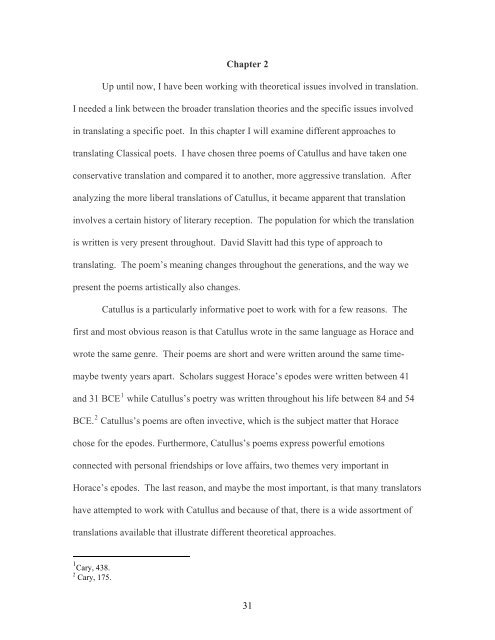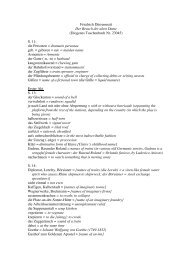A Log Cabin Out of Stone: - Dartmouth College
A Log Cabin Out of Stone: - Dartmouth College
A Log Cabin Out of Stone: - Dartmouth College
You also want an ePaper? Increase the reach of your titles
YUMPU automatically turns print PDFs into web optimized ePapers that Google loves.
Chapter 2<br />
Up until now, I have been working with theoretical issues involved in translation.<br />
I needed a link between the broader translation theories and the specific issues involved<br />
in translating a specific poet. In this chapter I will examine different approaches to<br />
translating Classical poets. I have chosen three poems <strong>of</strong> Catullus and have taken one<br />
conservative translation and compared it to another, more aggressive translation. After<br />
analyzing the more liberal translations <strong>of</strong> Catullus, it became apparent that translation<br />
involves a certain history <strong>of</strong> literary reception. The population for which the translation<br />
is written is very present throughout. David Slavitt had this type <strong>of</strong> approach to<br />
translating. The poem’s meaning changes throughout the generations, and the way we<br />
present the poems artistically also changes.<br />
Catullus is a particularly informative poet to work with for a few reasons. The<br />
first and most obvious reason is that Catullus wrote in the same language as Horace and<br />
wrote the same genre. Their poems are short and were written around the same time-<br />
maybe twenty years apart. Scholars suggest Horace’s epodes were written between 41<br />
and 31 BCE 1 while Catullus’s poetry was written throughout his life between 84 and 54<br />
BCE. 2 Catullus’s poems are <strong>of</strong>ten invective, which is the subject matter that Horace<br />
chose for the epodes. Furthermore, Catullus’s poems express powerful emotions<br />
connected with personal friendships or love affairs, two themes very important in<br />
Horace’s epodes. The last reason, and maybe the most important, is that many translators<br />
have attempted to work with Catullus and because <strong>of</strong> that, there is a wide assortment <strong>of</strong><br />
translations available that illustrate different theoretical approaches.<br />
1 Cary, 438.<br />
2 Cary, 175.<br />
31

















